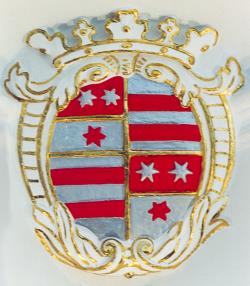|
This wonderfully ornate and typically picturesque German castle pearched
above the entrance to the valley of the Lauter (Lautertal) originated in the wake of a feudal system that ravaged Europe. It is steeped in
history which, at the turn of the 19th century even crossed paths
with and left traces on English monarchy. A small piece of a puzzle that fits well into several other connections
with British royalty and aristocratic society in this part of Germany (see Mountbatten below).
History
The castle, originally constructed as a fortress, is built on an
outcrop of high land above the river
Lauter that was a strategic vantage point able to defend and control movement along an
important thoroughfare leading from the
Rhine valley via Bensheim to Lindenfels and beyond. Although it was first documented in 1303 it is assumed that
the castle was built around 1230.
Schönberg, meaning beautiful hill, once belonged to the
earldom of Erbach near Michelstadt (approx. 40 km away on the other side of the
forest of Oden), which at the time was one of many seats of feudal power. Later in history the balance of power will shift many times as Erbach was close to the kingdom of Bavaria and attractive to the surrounding diocese like those of Mainz and Darmstadt. During such power struggles the
estate was often besieged and ransacked
as was the case in 1504 when the castle was seriously damaged by fire.
After the lords of Erbach were promoted to the status of counts in 1532 the county experienced a building boom which lead to the rebuilding of the castle. In 1696 the castle was again badly damaged. This time by plundering French troops.
|
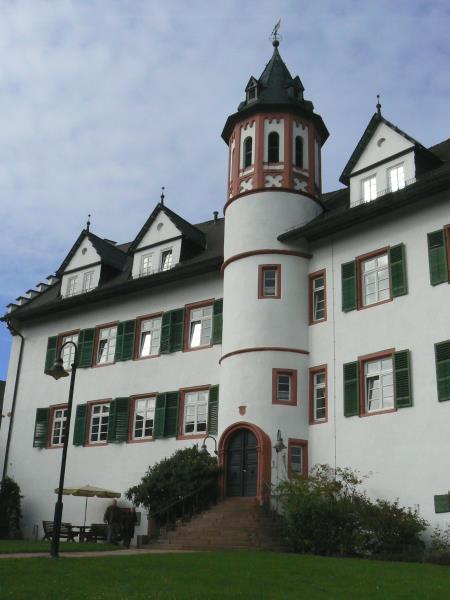
The main building
|
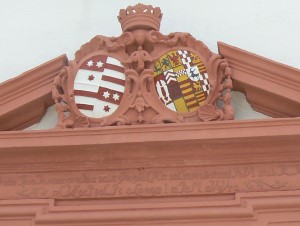 |
In 1717 the territories of Erbach were finally broken up and the
castle in Schönberg became the new seat of power of the house of Erbach-Schönberg under the
rule of Count Georg August. After relinquishing defenses and fortification,
further extensive building took place converting it into more comfortable living quarters in accordance with the general trend of the time. In 1732 Georg August took on the patronage for the protestant church in Reichenbach (now part of Lautertal) which was rebuilt in 1747. Whitness to this the castle arms of Schönberg can be seen above the main door (see photo - coat of arms on the left). Also in 1747 Erbach-Schönberg grew with the annexing of another aristocratic line of "Breuberg" whose arms
can also be seen above the main door of
this church.
|
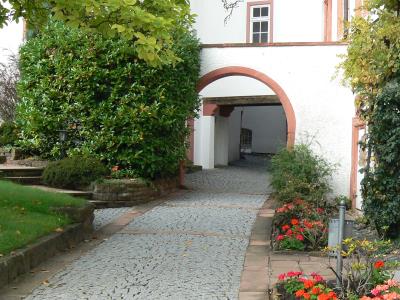
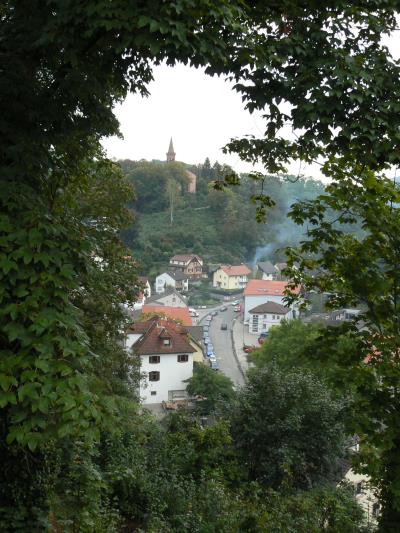 Around 1840/50 there was a redesign
of the main house, the north wing and also the courtyard where the eastern
terrace was built. The once extensive baroque gardens were remodelled into a
country park and many exotic trees planted. In 1902 the last major construction was added in the form of the pavilion and in 1903 the count was made
a duke. Schönberg itself was annexed to the town of Bensheim in 1939. Around 1840/50 there was a redesign
of the main house, the north wing and also the courtyard where the eastern
terrace was built. The once extensive baroque gardens were remodelled into a
country park and many exotic trees planted. In 1902 the last major construction was added in the form of the pavilion and in 1903 the count was made
a duke. Schönberg itself was annexed to the town of Bensheim in 1939.
The lords of Erbach first served the
abbey at Lorsch (a very important religious centre of the time - now UNESCO listed). This was,
in due course, to be changed which finally lead to them receiving the complete
jurisdiction over their land, to be redeemed only in 1806 when Napoleon formed the grand duchy of Hesse.
The counts of Erbach were officers in
the service of the Kaiser and as tutonic knights. The Imperial Field Marshal
Karl, Duke of Erbach-Schönberg received a special mention for bravery whilst
servicing for the Austrians in the
7-Years war (1756-63). Duke Ludewig participated in an unsuccessful campaign Napolean undertook against the Russians.
The true importance of the house of
Erbach was, though, more through the holding of high church office in the
important diocese of Worms, Speyer and Mainz. The greatest honour reached was
that of Dietrich Schenk who became elector and archbishop of Mainz in 1434. At the
same time he was also arch chancellor of the Holy Roman Empire.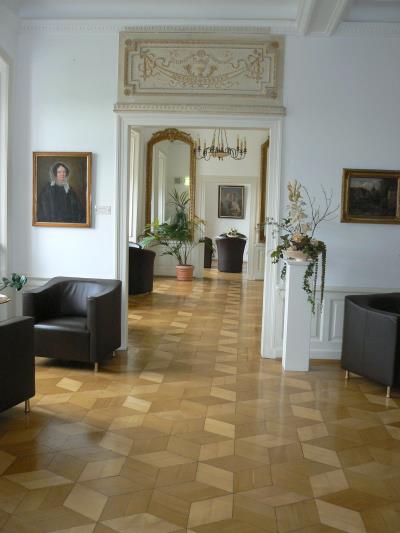
In 1871 Gustav Ernst of Erbach-Schönberg married Marie Princess of Battenberg who was
the niece of the Grand Duke of Hesse
and whose brother, Louis of Battenberg, was the Admiral of the Fleet in England at the time and to become the First Sea Lord of the Admiralty in 1914. This
immediately linked the house of
Erbach-Schönberg to the royal dynasties of Great Britain, Sweden, Greece and
Spain as well as the tsars of Russia. The once idyllic and rural tranquility of
the castle and its grounds was, for a while, turned into a centre of social activity of the
highest order.
This attracted such visitors such as
Queen Victoria who, in 1887, planted a lime tree in the castle park in honour of her greatgrandfather Georg August of Erbach-Schönberg. Also Tsar Alexander II of
Russia with spouse Marie, a princess of Hesse-Darmstadt, also came to visit on several occasions whilst staying at Heiligenberg at the Battenbergs. But soon this
flurry of activity began to wane in the wake of the looming 1st
World War.
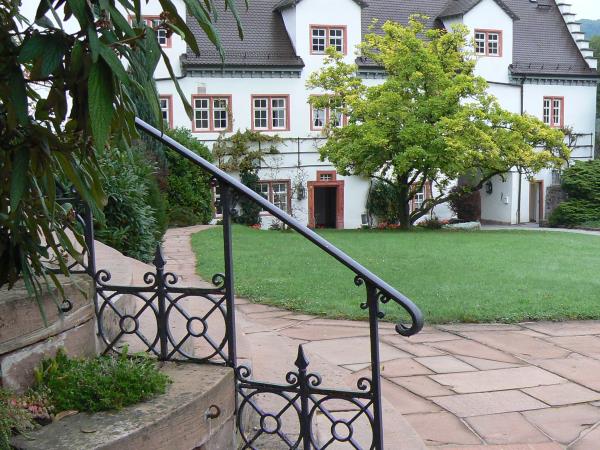 During the time following the dynasty of Erbach-Schönberg began to dissolve and part with its possessions.
Already during the 2nd World War the buildings were used as social
facilities and finally in 1956 this wonderful castle steeped in a long tradition was sold - to the
"Ruhrknappschaft" (a German miners’ insurance and social society) in Bochum, Ruhr - and
converted into a recreational centre for miners. Until recently the premises that had
been further adapted were used as a convention and training centre under the administration of the German state pension fund and kept in immaculate condition. The estate is now (February 2012) being offered on the market for a mere 13 million euros. One of the platforms used by the estate agents was even eBay! During the time following the dynasty of Erbach-Schönberg began to dissolve and part with its possessions.
Already during the 2nd World War the buildings were used as social
facilities and finally in 1956 this wonderful castle steeped in a long tradition was sold - to the
"Ruhrknappschaft" (a German miners’ insurance and social society) in Bochum, Ruhr - and
converted into a recreational centre for miners. Until recently the premises that had
been further adapted were used as a convention and training centre under the administration of the German state pension fund and kept in immaculate condition. The estate is now (February 2012) being offered on the market for a mere 13 million euros. One of the platforms used by the estate agents was even eBay!
Mountbatten (Battenberg)
|
Prince Philip, the Duke of Edinburgh is a Mountbatten. Although the Queen's family are officially Windsors, the family name Mountbatten still appears in many documents. The title Mountbatten was an anglification of the German Battenberg made necessary in 1917 due to bad feelings towards Germany after the 1st World War. Queen Elizabeth and Philip are distant cousins and both have Queen
Victoria as their great great grandmother (see line of nobility).
The Battenbergs had their family home in Heiligenberg in Jugenheim (approx. 10 km from castle Schönberg towards Darmstadt) until 1920, when, through lack of funds, they were forced to sell the estate. At this site there is still a family mausoleum.
|
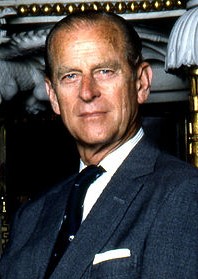
|
The name Battenberg refers to the dynasty which originated in
the town of Battenberg in north Hesse (twinned with Romsey, not far from the Isle of Wight in which Broadlands House is situated. This is the family home of Earl Mountbatten of Burma). The line died out in 1310 and remained dormant until 1858 when it was revived through the morganatic (or left-handed) marriage of Prince Alexander of Hesse-Darmstadt and Countess Julia Hauke, Polish born and of Roman Catholic confession which took place a few years earlier. The protestant church in Reichenbach (Lautertal) bears witness to the Mountbattens in the form of an ornate stained-glass window. The second son, Ludwig Alexander, married Queen Victoria's granddaughter, Victoria, in Darmstadt and settled in the UK.
Several of this line of the Battenbergs are buried on the Isle of Wight in the graveyard of St Mildred's Church in Whippingham which has a small replica of the original "Golden Cross" standing in Heiligenberg in Jugenheim, Germany. This area is closely connected with Queen Victoria. Prince Albert helped redesign the church, giving it an appearance similar to castles along the river Rhine in Germany. A side chapel there is dedicated to the Battenberg family. The third child of Ludwig and Victoria, George, is buried in the graveyard of St Michael's parish church in Bray near Windsor.
(Link to Windsor family tree)
(Glossary of Nobility English/German)
Written, compiled and all photographs (except Prince Philip): Johnny Glover, Lautertal
© 2010
|
